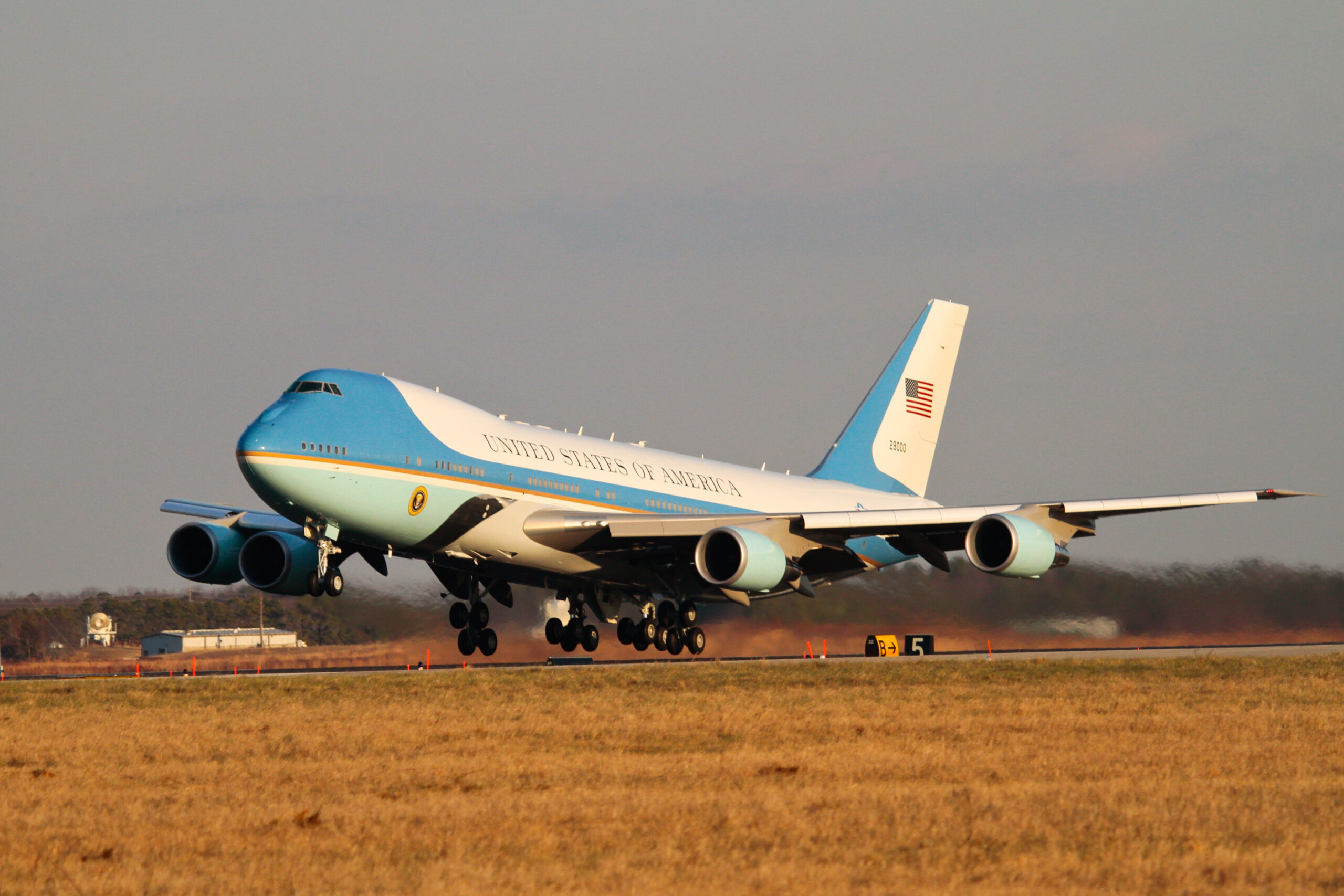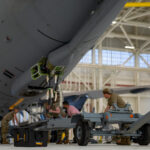The Air Force just pulled part of its Sentinel missile budget and pointed it at a different job: turning a Qatari Boeing 747-8 into a stop-gap Air Force One. The switch appeared in a Senate hearing on June 26. Secretary of the Air Force Troy Meink told lawmakers the dollars came from “early-to-need” lines that the missile team will not touch this year. Defense officials confirm the move keeps the main Sentinel timeline steady because no planned hardware ships late.
Every dollar matters. Sentinel’s cost estimate shot up to about $141 billion after fresh risk reviews. That spike forced a program reset and freed some money in the current fiscal cycle. The missile office paused orders for silo parts, guidance kits, and test hardware until the new baseline locks. Those delayed purchases left roughly the same amount of procurement authority sitting still. Similar unused allocations were noted in the House Appropriations Committee’s FY26 budget plan, where shifting funds became a key tool for meeting emerging priorities without raising toplines. Finance staff saw a chance to fund the jet without asking for extra cash.
Trump 747 Conversion Funded from Sentinel Budget Reshuffle
The Qatari aircraft, built in 2012 and flown by the Amiri Flight, logged fewer than 5,000 pressurization cycles. Engineers who inspected the jet in May found no major corrosion and no cracks in the wing root. Its clean record gives planners a fast foundation. They want to finish the retrofit in about twelve months once the plane reaches the L3Harris hangar in Waco, Texas.
Meink told the committee the total bill will “stay well below four-hundred million dollars.” Earlier independent guesses, made when the scope looked bigger, landed closer to one billion. By stripping non-critical extras, such as a large medical bay and extra luxury suites, the Air Force pulled the number down. Industry sources note that a tight spec also keeps schedule risk in check; every added room pushes wiring, cooling, and test time.
Work starts the moment the Air Force accepts the title, likely in early August. L3Harris has already run a full laser scan of the cabin and cargo decks. That scan feeds a digital model used to plot every new bracket, conduit, and antenna. The contractor also rehired several retired Boeing engineers who built the current VC-25A fleet back in the late-1980s. Their know-how should shorten design reviews and trim paperwork loops.
The Air Force needs relief fast. Each aging VC-25A now demands roughly eleven maintenance hours for every flight hour. Parts grow scarce, and corrosion hides behind panels. A younger jet reduces those headaches at once and lets maintenance teams slow down the wear on the older planes. When the long-delayed VC-25Bs finally roll in – now predicted for 2029 – the Qatari jet can shift to backup duty or go to the presidential library.
Interim Air Force One 747 Offers Fleet Maintenance Relief
Key hardware upgrades include:
- Reinforced floor beams under the future conference room.
- Aerial-refueling receptacle on the upper fuselage tied into the existing fuel-management system.
- Two AN/AAQ-24(V) infrared counter-measure turrets with gallium-nitride laser modules.
- Multi-band satellite antennas that link to Advanced Extremely High Frequency (AEHF) and commercial Ku.
- An encrypted local network for secure voice, data, and video.
- Power-conditioning racks that bridge the jet’s 235-volt variable-frequency buses to the 115-volt standard used by defense communications gear.
Most interior work stays modest. Designers will keep the forward lounge, fit a compact senior-staff cabin in the middle, and turn the aft lounge into a secure workspace with two desks. Galley space shrinks because the jet will fly shorter legs than the VC-25A fleet now handles. Leaving the medical suite out saves more than 4,000 pounds and clears room for extra backup batteries.
Trump Plane Interior Refocuses on Secure, Lightweight Design
The counter-measure turret needs laser-pump diodes from a single plant in Utah. A contamination event last winter cut output and left a six-month hole in deliveries. L3Harris placed an early order and opened a second inspection line, yet yield still lags. The team also watches titanium forgings for the floor beams. A Canadian mill plans an extra run in September, but labor shortages could slide the date.
Shifting money inside Aircraft Procurement, Air Force (APAF) avoids the long reprogramming drill that would involve four committees. APAF dollars stay live for five years. Because the funds never leave that account, accountants can move them without triggering Anti-Deficiency Act alarms. Still, the service sent a formal notice to Congress on June 24, and staffers reserved the right to freeze the cash if fresh issues appear.
Reaction on Capitol Hill splits along familiar lines. Some members praise the shuffle as smart stewardship. Others see a bad precedent: pulling deterrence money to buy what one aide called “a palace in the sky.” Appropriations Chair Patty Murray already plans language that caps any future transfers greater than $50 million unless Congress signs off. Members from missile-base states echo that call, warning that Sentinel might not absorb another funding pause.
Sentinel itself remains under heavy watch. Northrop Grumman rebuilt the schedule with digital-twin tools. The first booster launch now slides to 2027. Ground-system design review moves to late 2026. No fresh concrete pours at F.E. Warren Air Force Base until new seismic data clears review. Program leaders say the slower pace buys certainty: parts will show up when construction crews need them, not years early.
Sentinel Program Stability Preserved Despite Jet Funding Shift
The 747-8, powered by four GEnx-2B engines, brings clear performance gains. Its unrefueled range tops 7,700 nautical miles – about 600 miles beyond the VC-25A. Better fuel burn cuts tanker demand and leaves a wider safety margin on polar routes. New flight-management computers pick wind-optimized paths in real time, easing pilot workload and trimming fuel again.
Inside the cabin, cyber protection guides every rack. The local network splits “red” classified traffic from “black” unclassified traffic with a physical barrier. Each device owns a unique cryptographic ID. Firewalls update threat feeds every fifteen minutes over a narrow satellite pipe, giving the crew current data even in flight. Security testers will pound the system during electromagnetic-pulse trials next summer at the Naval Air Warfare Center.
The legal picture still needs daylight. A bipartisan Senate trio asked Defense Secretary Pete Hegseth on May 16 how accepting a state gift sidesteps the Constitution’s emoluments clause. The Defense Department leans on a section in last year’s defense bill that let the president receive the plane. A written opinion from the Office of General Counsel is due by July 15. Until that memo lands, critics keep pressing.
Key milestones follow a tight rhythm:
- August 2025 – Jet hand-over and induction in Waco.
- October 2025 – Critical design review using the full digital model.
- January 2026 – Power-on tests and first taxi.
- April 2026 – Communications integration in the hangar at Joint Base Andrews.
- June 2026 – Electromagnetic-pulse hardening trials.
- July 2026 – First nuclear command-and-control certification run.
- September 2026 – Final flight test and hand-over to the 89th Airlift Wing.
Logistics planners at Andrews already blocked hangar time. They also ordered a new ground power unit that matches the 747-8’s electrical needs. Aircrews will log about sixty simulator hours at Pan-Am Flight Academy before touching the real jet. That training cuts risk during early test flights and keeps the induction clock on track.
Trump Plane Test Schedule and Certification Milestones
The industrial base is wider than one hangar. Safran builds the auxiliary power unit in France. Collins Aerospace handles cabin pressure controls in Indiana. Honeywell produces the cockpit displays in Arizona. Smaller parts spread across at least six more states. Each contract slice keeps skilled labor busy and gives Congress one more reason to watch progress.
Risk boards meet each Thursday. Top threats now include the titanium-beam delivery, laser-diode yield, and extra cooling load on the avionics racks. Engineers added new heat sinks and ducting, yet total weight stays under the 1,300-pound growth ceiling set last month. If any item slips, program managers keep a backup plan: fly early trips with some gear deactivated but leave room for quick drop-in later.
Sentinel Program Offsets and Presidential Fleet Readiness Trade
Strategically, the budget transfer trades idle missile cash for near-term fleet readiness. Sentinel loses no time this year and gains schedule clarity after its reset. The executive airlift mission gets a younger airplane that needs less maintenance and offers more range. That bargain looks sound on paper, but the numbers must stick. A single cost spike could force the Air Force back to Congress, hat in hand.
Program leaders will publish a one-page fact sheet within thirty days of contract award. It will list cost, schedule, and performance benchmarks. The first big test comes at the October design review. Engineers must show that electrical loads, center of gravity, and electromagnetic limits all live inside their bands. A miss there pushes work into the next fiscal year and could trigger a new fight over transferred funds.
For now, crews on the Andrews flight-line welcome the news. Fewer hours on the VC-25As mean fewer corrosion discoveries and fewer late-night part hunts. With the Qatari jet in play, planners can spread missions across three airframes instead of two. That extra breathing room reduces risk every time the White House needs to move.
Long term, the retrofit offers a test bed. The modular satellite radome, the fast-swap avionics trays, and the cooling upgrades all scale to the VC-25B fleet. Lessons the Air Force learns here should shorten later installation time and keep workers proficient. The move also shows how digital design and steady oversight can cut a presidential-aircraft timeline in half.
Success will hinge on discipline. The scope must stay locked, and supply lines must deliver. If both happen, the jet should fly its first functional check next March. A smooth climb out of Waco will prove the early-to-need funding idea works. Any stumble will echo when Congress drafts next year’s appropriation. Either way, the project will set a clear signal on how the Pentagon balances nuclear modernization against the high-visibility needs of presidential travel.
REFERENCE SOURCES
- https://www.congress.gov/
- https://insidedefense.com/daily-news/dollars-sentinel-program-were-shifted-fund-retrofit-qatari-air-force-one-jet
- https://www.defensenews.com/air/2025/06/05/air-force-pegs-cost-to-modify-qatar-gifted-plane-at-less-than-400m/
- https://breakingdefense.com/2025/06/turning-qatari-jet-into-air-force-one-would-cost-less-than-400-million-air-force-secretary-says/
- https://www.reuters.com/business/aerospace-defense/retrofitting-qatari-jet-air-force-one-trump-cost-hundreds-millions-dollars-air-2025-06-05/
- https://www.wsj.com/business/airlines/air-force-one-trump-qatari-jet-l3harris-fc903838
- https://ground.news/article/air-force-using-sentinel-money-to-retrofit-qatar-jet
- https://www.defenseone.com/defense-systems/2025/06/air-force-using-sentinel-money-retrofit-qatar-jet/406384/
- https://www.airandspaceforces.com/nuclear-missile-funds-excess-air-force-one/
- https://www.theguardian.com/us-news/2025/may/28/trump-qatar-plane-gift-boeing
- https://www.npr.org/2025/05/21/nx-s1-5406420/trump-accepts-qatar-plane-air-force-one



